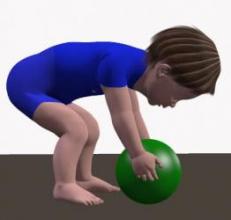What is functional strength training?
Functional strength training uses movement patterns that are common in everyday actions, such as stepping and down, squatting, sitting up from lying and so on.
Because functional strength training uses complex combinations and sequences of movements it has the advantage of improving flexibility, balance and coordination as well as strength.
Functional strength training leads to improvements in strength when the activity is adapted so as to increase the load against which the muscles need to work. Increasing the load to a level that is greater than encountered in everyday life leads to an adaptive response in the muscles that allow them to cope with the increased demand. In other words, loading a muscle leads to an increase in muscle strength.
Functional strength training for Sim
Sim's leg extensor muscles are weak. He cannot squat down and stand up again without some hand support. So I have chosen a game where he has to bend his knees halfway towards a full squat. This task is easier than squatting, but uses the same muscles in ways that are similar to squatting.
Sim flexes the knees as he bends down to pick up the big ball, then lifts it above his head to throw it. This requires leg, trunk (core) and arm strength. I roll the ball back to him, so that he has to bend to pick it up again.

He repeats this action 8 times with relative ease, then starts to tire and wants to change the game. So we change to a kicking game for a little while, followed by to practicing standing up and sitting down on a low step. This activity also works the weak hip and knee extensor muscles.

The 10-repetition-to-fatigue rule
Muscles get stronger when they work against a load which is greater than usual.
If you go to the gym you will know all about the 10 repetition to fatigue rule. The load (resistance) is adjusted so that you can do 10 repetitions with good control. Then your muscles are tired and your control of the movement decreases.
Test your squatting repetition maximum
How many times can you do a full squat and stand up again with a smooth movement? This is your squatting repetition maximum.
If you are fairly fit you will be able to 15 plus squats with ease.
Now lets make the exercise a little more difficult.
Do a full squat and stand up as fast as you can. How many fast squats can you do with good control?
Speeding up an exercise increases the load.
You can also increase the load by holding a weight.
How many times can you squat with good control holding a 2 liter bottle of water in each hand?
Another example of functional strength training for a toddler
Stepping up onto a low step
At 2 1/2 years Jamie has difficulty stepping up onto a 10 cm high step without some hand support. To improve his leg muscle strength and balance for stepping up, we start practicing stepping up into a 5 cm high step placed near a chair to provide hand support. After some practice he manages this easily, so I increase the height of the step to 10 cm.

I place a 10 cm high step between to stools and roll a ball through the gap and encourage Jamie to chase the ball. He enjoys this game and he happily chases the ball up and down over the step 10 times, each time stepping up onto, and then down from, the block.
.
Then he looses interest, perhaps because he is getting tired. I am pleased that his leg muscles are tired, because it means that they have worked hard enough to get an adaptive response with an increase in muscle strength and coordination.
So we stop, sit down on the floor and play with blocks for a few minutes. Then we return to the ball chasing game.
Jamie's mom and I talk about different ways Jamie can practice stepping up and down at home.
Two weeks later when see I Jamie and his mom again, he proudly shows me that he can step up onto my 10 cm high step without hand support. His mom also reports that Jamie's confidence has improved walking over rough ground in the park. We are all pleased with his progress.
Read more
Gross motor skills a 2-3 year old should be able to do
A list of all the different gross motor tasks a toddler should master before the age of 3 years.







